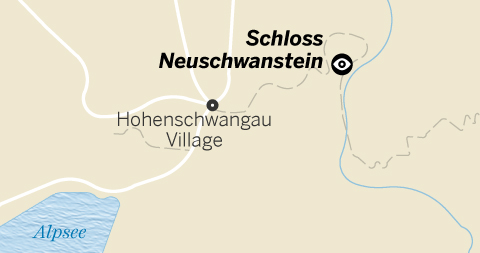TOP EXPERIENCE
Schloss Neuschwanstein, Germany
Appearing through the mountainous forest like a mirage, Schloss Neuschwanstein was the model for Disney’s Sleeping Beauty castle. King Ludwig II drew the blueprints for this fairy-tale pile himself. He envisioned it as a giant stage on which to recreate the world of Germanic mythology, inspired by the operatic works of his friend Richard Wagner.

Great For…
 yDon’t Miss
yDon’t Miss
The excellent Museum der Bayerischen Könige (Museum of the Bavarian Kings; www.museumderbayerischenkoenige.de; Alpseestrasse 27; adult/child €11/free; ![]() h9am-5pm) is a short walk from the castle ticket office.
h9am-5pm) is a short walk from the castle ticket office.
 8Need to Know
8Need to Know
![]() %tickets 08362-930 830; www.neuschwanstein.de; Neuschwansteinstrasse 20; adult/child €13/free, incl Hohenschwangau €25/free;
%tickets 08362-930 830; www.neuschwanstein.de; Neuschwansteinstrasse 20; adult/child €13/free, incl Hohenschwangau €25/free; ![]() h9am-6pm Apr–mid-Oct, 10am-4pm mid-Oct–Mar
h9am-6pm Apr–mid-Oct, 10am-4pm mid-Oct–Mar
 oTop Tip
oTop Tip
Arrive as early as 8am to make sure you bag a ticket for that day.

Ludwig II, the Fairy-Tale King
King Ludwig II’s obsession with French culture and the Sun King, Louis XIV, further inspired the fantastical design.
Ludwig was an enthusiastic leader initially, but Bavaria’s days as a sovereign state were numbered, and he became a puppet king after the creation of the German Reich in 1871. Ludwig withdrew completely to drink, draw up castle plans and view concerts and operas in private.
In January 1886, several ministers and relatives arranged a hasty psychiatric test that diagnosed Ludwig as mentally unfit to rule. That June, he was removed to Schloss Berg on Lake Starnberg. A few days later the dejected bachelor and his doctor took a Sunday-evening lakeside walk and were found several hours later, drowned in just a few feet of water. No one knows with certainty what happened that night, and conspiracy theories abound. That summer the authorities opened Neuschwanstein to the public to help pay off Ludwig’s huge debts. King Ludwig II was dead, but the myth was just being born.
Construction
Built as a romantic medieval castle, the grey-white granite pile was begun in 1869 but was an anachronism from the start: at the time of Ludwig’s death in 1886, the first high-rises had pierced New York’s skyline. However, despite his love for the old-fashioned look, the palace had plenty of high-tech features, including a hot-air heating system and running water. Like so many of the king’s grand schemes, Neuschwanstein was never finished. For all the coffer-depleting sums spent on it, the king spent just over 170 days in residence.
The Interior
The most impressive room is the Sängersaal (Minstrels’ Hall), whose frescoes depict scenes from Wagner’s opera Tannhäuser. Other completed sections include Ludwig’s Tristan and Isolde–themed bedroom, dominated by a huge Gothic-style bed crowned with intricately carved cathedral-like spires; a gaudy artificial grotto (another allusion to the Tannhäuser); and the Byzantine-style Thronsaal (Throne Room) with an incredible mosaic floor containing over two million stones. The painting opposite the (throneless) throne platform depicts another castle dreamed up by Ludwig that was never built.

Schloss Hohenschwangau
King Ludwig II grew up at the sun-yellow Schloss Hohenschwangau (![]() %08362-930 830; www.hohenschwangau.de; Alpseestrasse 30; adult/child €13/free, incl Neuschwanstein €25/free;
%08362-930 830; www.hohenschwangau.de; Alpseestrasse 30; adult/child €13/free, incl Neuschwanstein €25/free; ![]() h8am-5pm Apr–mid-Oct, 9am-3pm mid-Oct–Mar) and later enjoyed summers here until his death in 1886. His father, Maximilian II, built this palace in a neo-Gothic style atop 12th-century ruins left by Schwangau knights. Far less showy than Neuschwanstein, Hohenschwangau has a distinctly lived-in feel where every piece of furniture is a used original. After his father died, Ludwig’s main alteration was having stars, illuminated with hidden oil lamps, painted on the ceiling of his bedroom.
h8am-5pm Apr–mid-Oct, 9am-3pm mid-Oct–Mar) and later enjoyed summers here until his death in 1886. His father, Maximilian II, built this palace in a neo-Gothic style atop 12th-century ruins left by Schwangau knights. Far less showy than Neuschwanstein, Hohenschwangau has a distinctly lived-in feel where every piece of furniture is a used original. After his father died, Ludwig’s main alteration was having stars, illuminated with hidden oil lamps, painted on the ceiling of his bedroom.
Castle Tickets & Tours
Schloss Neuschwanstein and Hohenschwangau can only be visited on guided tours (in German or English), which last about 35 minutes each (Hohenschwangau is first). Strictly timed tickets are available from the Ticket Centre (![]() %08362-930 830; www.hohenschwangau.de; Alpenseestrasse 12;
%08362-930 830; www.hohenschwangau.de; Alpenseestrasse 12; ![]() h7.30am-5pm Apr–mid-Oct, 8.30am-3pm mid-Oct–Mar) at the foot of the castles.
h7.30am-5pm Apr–mid-Oct, 8.30am-3pm mid-Oct–Mar) at the foot of the castles.
Enough time is left between tours for the steep 30- to 40-minute walk between the castles. All Munich’s tour companies run day excursions out to the castles.
 oClassic Image
oClassic Image
For the postcard view of Neuschwanstein, walk 10 minutes up to Marienbrücke (Mary’s Bridge).